Dairy Cases
The milk cure in eighteenth-century France
Meredith Martin
What kind of taste and organs must those people have, who really prefer the adulterate enjoyments of the town to the genuine pleasures of a country retreat?
—Tobias Smollett, The Expedition of Humphry Clinker, 1771
Around 1750 on the outskirts of Paris, designers at King Louis XV’s porcelain manufactory began producing a type of cup for drinking milk known as the “milk goblet,” or gobelet à lait. Available in two sizes, the cups had one or two handles and a cover to keep the milk warm. They were often decorated with country scenes and painted in pastel hues like “Pompadour pink,” named after Louis XV’s mistress Madame de Pompadour, who was one of the factory’s most important patrons. In the 1750s, milk goblets became popular among the French nobility and the court, and they were also given away as gifts to foreign dignitaries.[1]
Part of the cup’s appeal stemmed from the material out of which it was made. Beginning in the fifteenth century, porcelain from China had been imported into Europe in ever-growing quantities, and it was fiercely coveted among European elites, so much so that in 1717 the ruler of Saxony, Augustus the Strong, traded six hundred of his cavalrymen to the king of Prussia in exchange for 151 porcelain Ming vases. The soldiers became known as the Porcelain Regiment.[2] For centuries, European artisans had struggled to imitate this Asian “white gold,” but it wasn’t until 1709 that the Saxon alchemist Johann Friedrich Böttger figured out how to manufacture true or hard-paste porcelain, which was done by combining a hard, feldspathic rock known as petuntse with kaolin, a white clay common to both Asia and Europe.
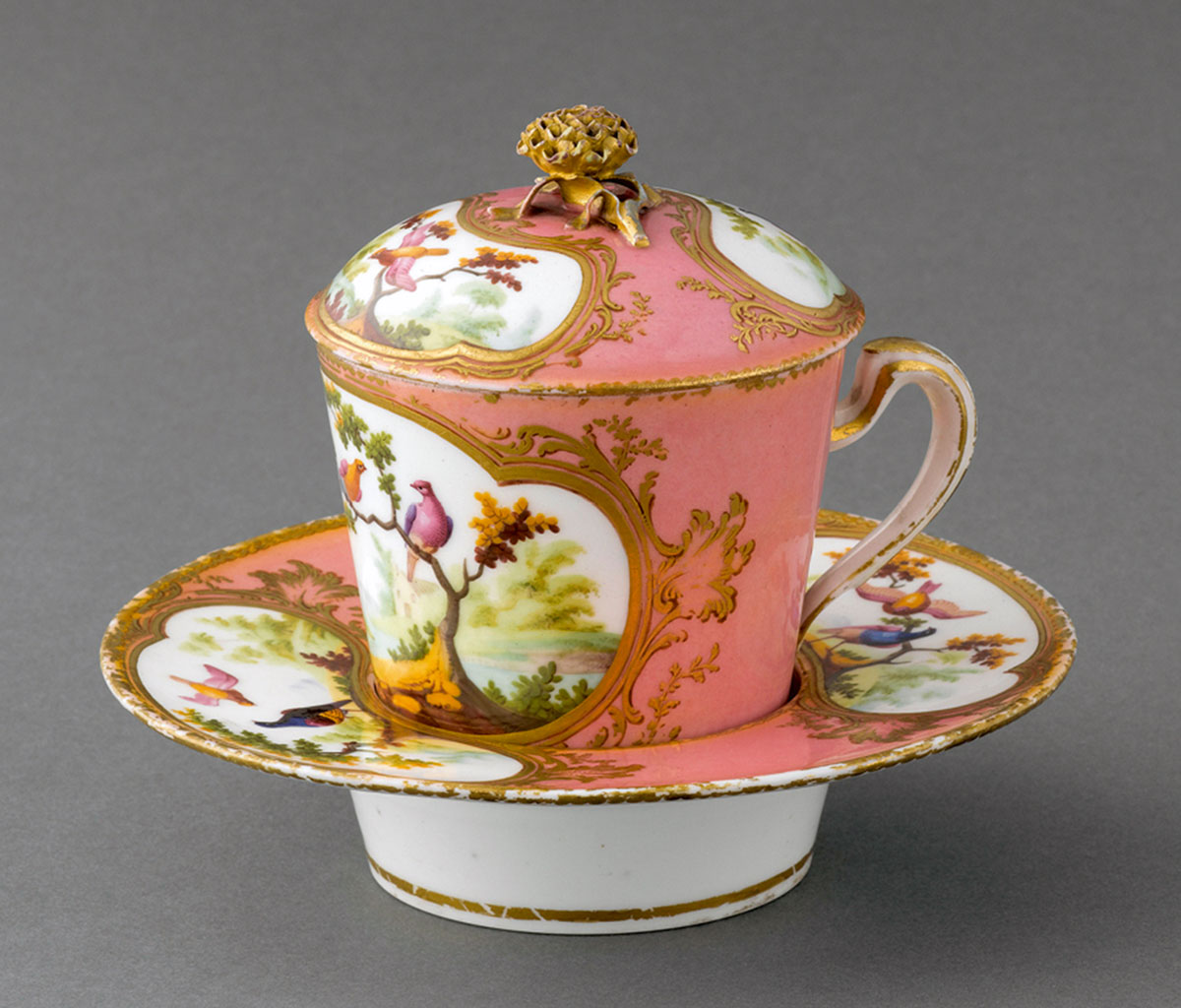
Böttger was put in charge of Augustus the Strong’s new factory at Meissen, the first European producer of hard-paste porcelain. Meissen’s success spurred other European rulers to found their own factories and attempt to divine or steal the formula. Louis XV’s manufactory had been founded in 1740 at Vincennes near Paris, and in 1756 it was moved to Sèvres on the opposite side of the city. Although the Sèvres factory didn’t begin producing true porcelain until the late 1760s—shortly after French manufacturers stumbled upon a large deposit of kaolin near Limoges—in the early years they developed an artificial soft-paste version made of clay and powdered glass that was admired by wealthy collectors across Europe. The milk goblet shown above was made using this soft-paste technique, adding to its status as an object of desire and prestige.
However, it was the milk cup’s function that truly ensured its popularity among French high society in the 1750s. While drinking fresh milk is ubiquitous in the West today, it was a novelty, at least among adults, in early modern Europe, when people of all classes were more likely to consume dairy products in the form of butter or cheese. Prior to the nineteenth-century development of pasteurization and refrigeration, fresh milk spoiled too quickly to be regularly or widely consumed, especially among city residents. Milk was, however, prescribed as a medicinal remedy in antiquity and the Renaissance, and this practice was revived in eighteenth-century Europe as part of a back-to-nature health craze aimed at urban elites, and elite women in particular.[3]
The milk cure was associated with the neo-Hippocratic revival of medicine, which, according to historian William Coleman, had become by 1750 “an integral part of a new and largely secular moral order.”[4] Supplanting earlier medical theories that focused solely on the body’s internal dynamics, the new Hippocratic code emphasized diet, hygiene, environment, and lifestyle. Eighteenth-century physicians who subscribed to this code—among them Samuel Tissot, who corresponded with Jean-Jacques Rousseau and wrote bestselling treatises on the perils of masturbation, high-class urban living, and excessive scholarly activity—urged their predominantly elite patients to repair to the countryside and rid themselves of the city’s deleterious influences by taking in fresh air and sunlight, enjoying moderate exercise, and consuming milk and other wholesome foods. Tissot believed that this regimen would salvage the morals as well as the health of his patients by bringing them closer to a prelapsarian state of nature. It would also put them in contact with the rural peasantry, whose rustic diet and idealized devotion to work and family Tissot, in a utopian fashion, encouraged his followers to emulate.[5]
Milk, a substance that Rousseau identified with pastoral purity and the “natural” innocence and sweetness of women, was an essential part of the back-to-nature health campaign.[6] Although physicians debated its efficacy in treating certain illnesses and constitutions, milk was generally believed to function as a non-violent purgative that penetrated and opened the body’s channels, allowing fresh air to enter and toxins to exit. It could also be used to remove obstructions in the lungs, chest, and bowels, returning the body to its optimal balance or flow. In an article on milk for the Encyclopédie (1751–1765), the French royal physician Gabriel-François Venel touted its success in treating nerve disorders along with chest and stomach ailments, fever, gout, and venereal disease. Venel preferred to prescribe cow’s milk, while other physicians maintained that ass’s, goat’s, or even human breast milk was superior. He also recommended that fragile patients drink whey, or the watery part of milk that remains after curdling, because it was easier to digest than whole milk. Whey was considered especially good for those suffering from the “hypochondriacal and hysterical illnesses” that were thought to be alarmingly on the rise in this period, notably among women.[7]
The Encyclopédie’s advice, echoed in publications from the 1750s to the 1780s, stimulated a mania for the milk diet among aristocrats and Enlightenment philosophes alike. Diderot and Voltaire both tried it, and Rousseau enjoyed bathing in whey and also drinking it. By the mid-1780s, the Parisian journalist Louis-Sébastien Mercier could comment ruefully on how “the rich eat much less than they used to … you may see your host, at the head of his magnificent table, dismally sipping a glass of milk,” and he could also report on strenuous efforts to import in-demand Swiss dairy cows to Paris, which city residents believed would give them “a new lease on life” until they were disappointed to discover that the Alpine creatures could not thrive “on our thin French fields.”[8] Undaunted by such challenges, Parisian physicians and businessmen parlayed the siren call of nature into lucrative enterprises, churning out testimonials, treating scores of gullible patients, and designing alluring products like rouge made from vegetable dye and the tronchine, a short, unstructured dress that women could wear while walking outdoors. (The tronchine was developed by Théodore Tronchin, who treated Voltaire and the French royal family.) For those who could not obtain fresh milk—or who had no wish to leave the city—substitute remedies were devised such as “Franchipane,” a milk-and-herb extract invented by the German physician Friedrich Hoffmann that promised nature in a bottle.[9]
At the high end of this market, the porcelain milk goblet offered the possibility of returning to nature in an artful manner, while also participating in the latest health trends. The Sèvres cup shown above embodies a rose-colored vision of country life, and was engineered expressly with the milk cure in mind. First, it was large enough to contain the pint (chopine) of milk that patients were advised to consume once or twice daily. The handle aided an infirm drinker’s shaky grasp, and it also kept hands free of the cup’s hot surface, since milk was often served warm to promote relaxation and digestion. The cover conserved this warmth and kept the liquid free of wig powder or other contaminants that could fall in during the morning ritual of the toilette, when milk was frequently served.
The most striking visual element of this particular milk goblet may be its recessed or “socketed” saucer, which allows the cup to fit snugly into its base. Introduced by the Sèvres factory in 1759, this type of saucer was apparently designed to prevent anxious or feverish milk drinkers—especially elite women suffering from nervous disorders like hysteria or “the vapors”—from knocking the cup over and shattering it. The cup-and-saucer ensemble is sometimes referred to as a “trembleuse,” an eighteenth-century term that evoked the trembling hands of the fragile patients who gripped these vessels.[10] The seeming urgency for such a cup is evident in the many eighteenth-century novels that feature overly sensitive characters, usually women, who are so overcome by emotional travails or the pressures of urban life that they have been reduced to a perpetual state of nervous trembling. Two of the best-known examples are Samuel Richardson’s heroines Pamela and Clarissa, whose eponymous novels were published in 1740 and 1747–48, respectively. Clarissa admits at one point to being so “choked with vapours” that she cannot finish a milk-and-tea concoction she is given for her health, while Pamela describes her hands shaking so badly that she spills a cup of hot chocolate during an episode in which she agonizes over marrying her wealthy but possibly unscrupulous employer, Mr. B.[11]
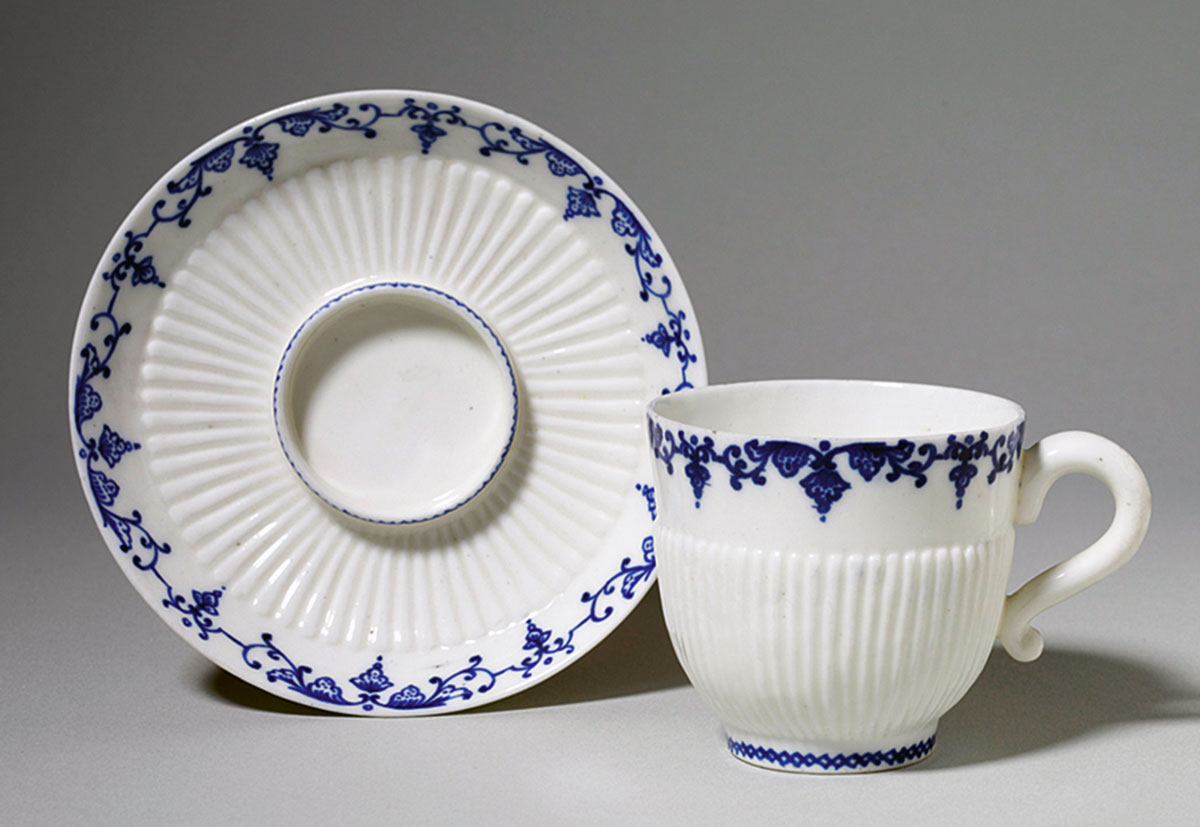
An earlier type of trembleuse cup had been invented in the late seventeenth century at Saint-Cloud, France’s first commercially viable producer of soft-paste porcelain. The Saint-Cloud trembleuse was designed for consuming coffee, tea, and chocolate: exotic beverages that had only recently been made available in France and were initially thought to possess restorative or medicinal properties. A treatise published on these beverages in 1685 attested to their ability to alleviate gout, the vapors, infertility, and consumption.[12] Unlike the Sèvres cup’s recessed saucer, the Saint-Cloud saucer had a raised central ring or “gallery” for securing the cup that resembled a mancerina, a cup-and-saucer combination used primarily for drinking chocolate. The mancerina was named after the Marqués de Mancera, the Spanish viceroy of Peru from 1639 to 1648, who had helped import chocolate from the New World and drank large quantities of it himself to treat his palsy.[13]
Most Saint-Cloud trembleuses are ornamented with blue and white arabesque motifs that were fashionable in France in the late seventeenth century. The shape and color of these cups derived from Chinese porcelain prototypes and called to mind the exotic nature of the beverages they contained. As trembleuses grew in popularity in the early eighteenth century, newly minted porcelain manufactories scrambled to create their own versions of these vessels. The most elaborate were the trembleuses made by the Du Paquier factory in Vienna (founded in 1718), which featured an intricate, pierced gallery that showcased the fragile nature of both the material and the consumer.[14] Clients purchased trembleuse cups not just because of their usefulness but also because they had the ability to suggest an owner’s delicate constitution or nervous sensitivity, which became what historian Roy Porter has described as a “badge of gentility” among the eighteenth-century European elite.[15]
In the first half of the eighteenth century, coffee, tea, and chocolate became all the rage in Europe. Some members of the Enlightenment medical community, however, began denouncing these substances, arguing that they could actually provoke some of the ailments they were formerly believed to alleviate.[16] Coffee, tea, and chocolate were also tied to the urbane lifestyle that mid-century physicians and social reformers began widely to condemn as physically and morally enervating. Though these drinks remained popular, they were eclipsed after 1750 by new beverages that extolled the regenerative virtues of country living, including milk served by itself rather than combined with these products.
One of the most fervent devotees of the back-to-nature trend in France was Madame de Pompadour, Louis XV’s mistress from 1745 until her death in 1764. Pompadour suffered from poor health throughout her years at court—her chronic fevers, nervous attacks, and lung problems are amply documented in court memoirs—and she spent much of her time in the company of her physician, François Quesnay, who encouraged her to drink milk and adopt the new natural remedies. (Pompadour and Quesnay co-hosted a salon at Versailles attended by such cutting-edge intellectuals as Diderot and d’Alembert, where the new medical theories were discussed.)[17] A 1758 portrait of Pompadour by her favorite artist, François Boucher, depicts her promoting the rejuvenating effects of nature while she reads a book, possibly one of the many medical treatises in her library. One of these treatises, Antonio Cocchi’s The Pythagorean Diet, of Vegetables Only, Conducive to the Preservation of Health and the Cure of Diseases (1743), endorsed the healing power of nature, vegetables, and milk.
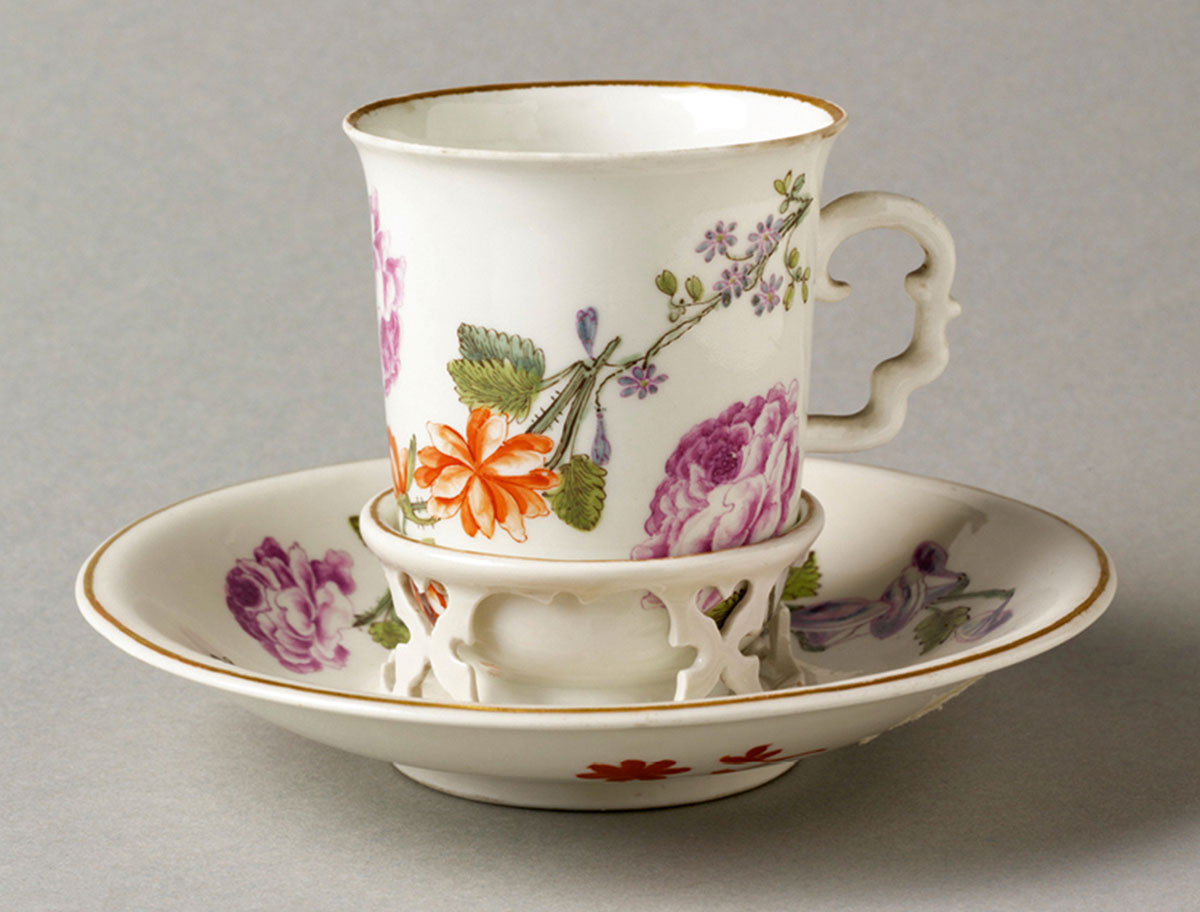
Pompadour acquired several milk goblets in the 1750s, and between 1759 and her death in 1764 she seems to have purchased every trembleuse cup with a recessed saucer that the Sèvres factory produced.[18] She took her therapeutic regimen to even more lavish extremes by commissioning quasi-rural retreats near the royal palaces of Versailles, Fontainebleau, and Compiègne, where she could escape to pastoral seclusion for an afternoon or more. These retreats, known as “hermitages,” were named after rural huts inhabited by recluses or monks seeking isolation and spiritual contemplation. Pompadour’s refuges, by contrast, proclaimed a new religion of nature and were dedicated to purifying the body as well as the mind. Along with sizeable gardens, they all featured cow stables and dairies for the production of milk and whey, which she consumed on a regular basis.
Visited by courtiers throughout the 1750s, Pompadour’s dairies, like her hermitages, represented an elegant and sophisticated vision of rural life. They were airy pavilions outfitted with marble tables, statues of milkmaids, and porcelain milk goblets that she purchased from her Parisian art dealer Lazare Duvaux. As spaces in which to “perform,” as much as participate, in the new cultural trends, they belonged to a type of garden building known as the pleasure dairy, or laiterie d’agrément, that became popular among the French aristocracy around the mid-eighteenth century. Following Pompadour’s example, royal women like Marie-Antoinette and Josephine de Beauharnais built pleasure dairies to flaunt their superior health, taste, and commitment to the land, modeling themselves on Rousseau’s virtuous heroine Julie, who runs her own pastoral community and dairy at Clarens in the bestselling novel Julie, ou La nouvelle Héloïse (1761).
Marie-Antoinette’s pleasure dairy, built in the 1780s as part of her faux-rustic hamlet (Hameau) at Versailles, exemplified this building type in its blend of outward simplicity and interior refinement—representing an architectural analogue of the pastoral literary mode. Often dismissed as the wasteful folly of a frivolous queen, the Hameau’s dairy was in fact part of a larger trend of similar structures created during this time on the grounds of palaces, country estates, and even in the gardens of wealthy Parisians, and they remain important in our understanding of the creative relationship between the aristocracy and leading artists and architects of the day, including Hubert Robert, François Boucher, and Claude-Nicolas Ledoux. Moreover, pleasure dairies allowed elite owners to experience the pleasures, and embrace the values, of rural life without having to abandon their urban-oriented lifestyles or their courtly responsibilities.
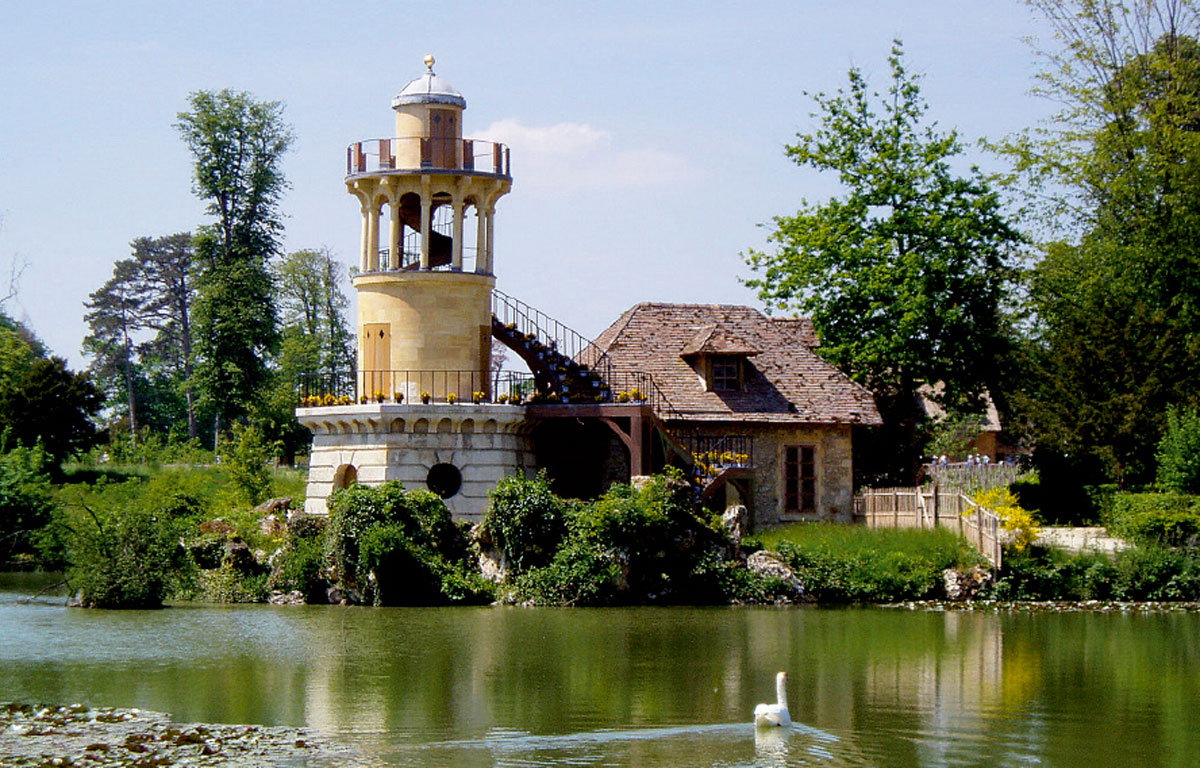
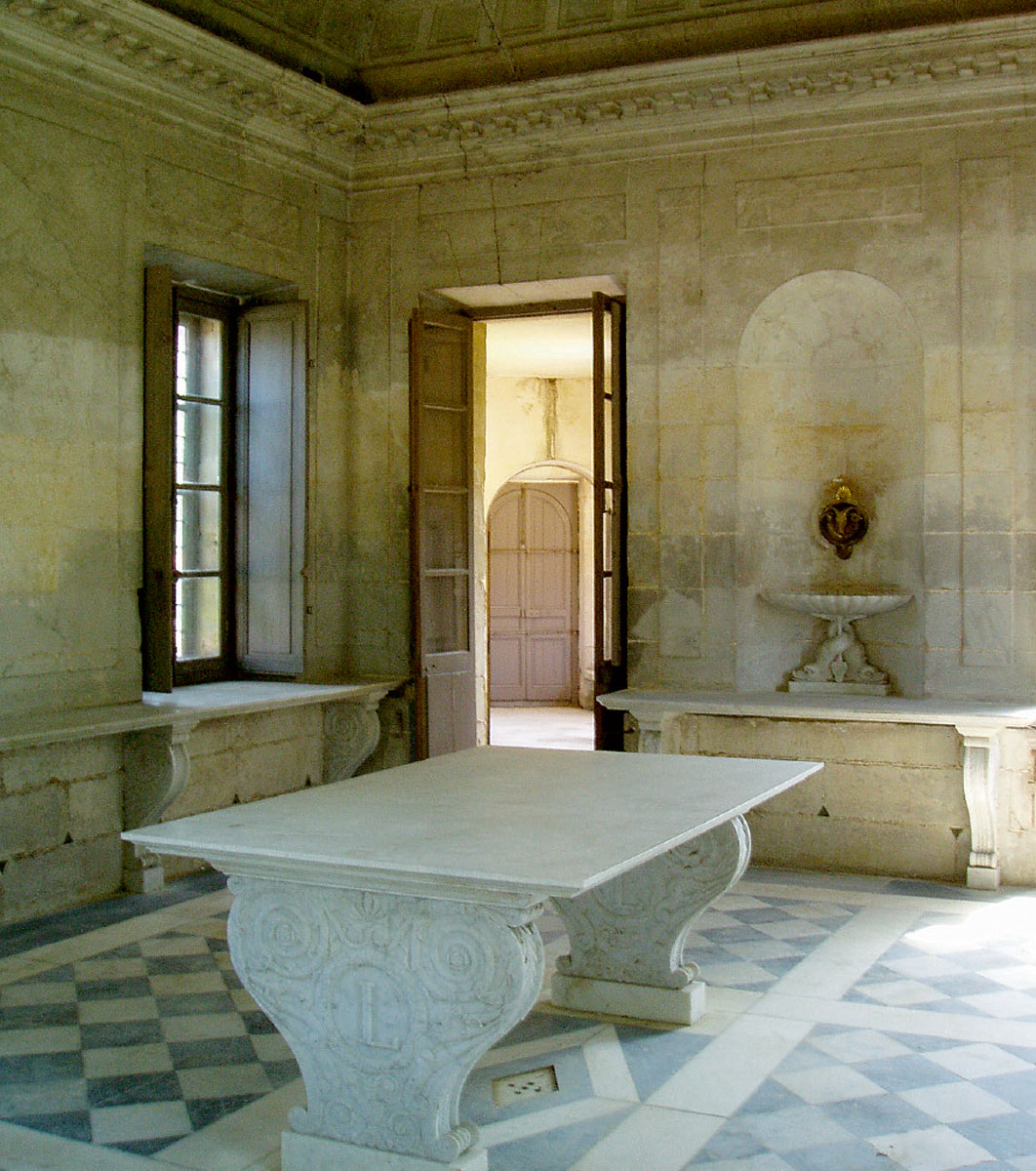
These buildings and their stylish gardens drew harsh complaint, however, from Enlightenment reformers and physicians, who worried that their owners were mocking the rhetoric of pastoral retreat or turning it into a bankrupt performance. In the 1770s Louis de Carmontelle capitalized on this anxiety by writing a satirical play about a Parisian noblewoman who fakes a hysterical attack so that her doctor will prescribe a milk diet, conning her husband into whisking her away to their country house just so she can entertain her friends there.[19] Marie-Antoinette’s critics went much further by accusing her of using her garden retreat, with its connotations of feminine virtue, as a haven for indulging in degenerate sex acts with her male relatives and female friends. Rumors about the queen’s misconduct in her gardens appeared in pornographic pamphlets written about her before the Revolution, and they reappeared during her trial of 1793, shortly before she was guillotined.[20] Attacks against Marie-Antoinette may have been in the extreme, but in the late eighteenth century it was common to label a woman unnatural or corrupt if she did not embrace the “genuine pleasures” of country living and the attendant values of domesticity, or, worse yet, if she was thought to fake a sincere attachment to those values for her own selfish ends.
Medical treatises published in this period, many of which were written by physicians attached to the court, encouraged husbands and colleagues to forcibly transplant women to the countryside if they refused to go gently in order to be “cured.” One of these treatises, D. T. de Bienville’s Nymphomania or Treatise on the Uterine Furies (1771)—“uterine furies” being a popular term for the sexually specific form of hysteria or the vapors—reads more like a gothic novel than a scientific tract. It is filled with scurrilous accounts of wayward women whom the author had personally saved by insisting on a strict regimen of country isolation, warm baths, and milk. In one such account involving an oversexed teenager named “Eléonore,” Dr. Bienville describes how he delivered this “monstrous,” perpetually “trembling” young girl to his own country house and fed her a purifying diet of white meat and milk while also administering daily injections of milk into her vagina, which to his satisfaction made her clitoris recede.[21] By the end of his tale, he proudly proclaims that Eléonore is not only completely cured but that she has also re-entered society and found a husband. Bienville’s treatise underscores the extent to which the back-to-nature campaign could be used as a tool by men to police women, to delimit their identity and their desire, and to define their “natural” place in society—anticipating the treatment of so-called hysterical women in the nineteenth century and beyond.
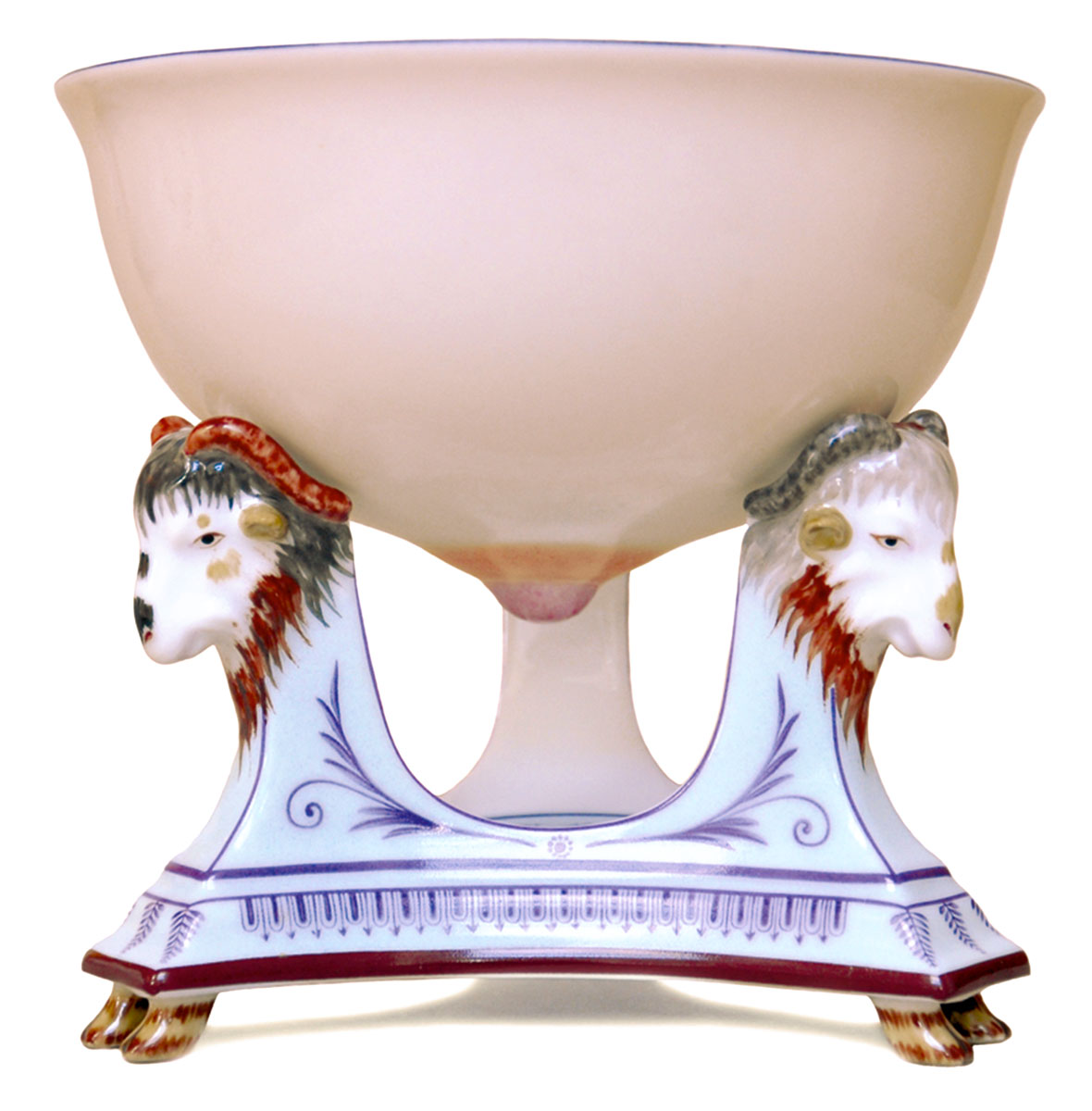
Anti-royal pamphlets also accused Marie-Antoinette of suffering from “uterine furies.”[22] In an effort to reform the queen’s image and extricate her from her sullied gardens and Hameau, Louis XVI’s building director, Charles-Claude Flahaut de la Billarderie, Comte d’Angiviller, commissioned a second dairy around 1785 for Marie-Antoinette at the royal estate of Rambouillet, where the king spent his days hunting. The Rambouillet dairy, whose exterior resembled a neoclassical temple, was intended to convey social, political, and aesthetic renewal on a grand scale. Inside was a womblike grotto crowned by a statue of the mythological nymph Amalthea, who according to Ovid’s Fasti had nursed the infant Jupiter with goat’s milk while he was separated from his mother. Surrounding her were plaques, made of a milky marble, depicting similarly dutiful women performing domestic tasks like churning butter, shearing sheep, and breastfeeding children—referring to a contemporary campaign of social renewal, promoted by Rousseau among others, that entreated Frenchwomen to nurse their own children instead of hiring wet nurses.
Breastfeeding and (animal) milk consumption were further aligned in a suite of antique-inspired Sèvres porcelain that d’Angiviller commissioned for the dairy, which included a milk goblet shaped like a woman’s breast. To drink from it, one had to lift the flesh-colored cup carefully from its tripod base, cradle the breast in both hands, and sip milk from the rim. In its design and use, the Rambouillet breast cup embodied both the yearning for regeneration and the erotic impulses associated with the milk cure that reformers were working so hard to sublimate or suppress. D’Angiviller had hoped that visitors would visit the Rambouillet dairy and be inspired by its message of royal rebirth, but by the time the dairy was finished in 1788, fewer of the crown’s subjects were willing to regard the monarchy as redeemable or the queen as maternal rather than hopelessly dissolute. For her part, Marie-Antoinette preferred her pastoral retreat at Versailles, in whose gardens she was supposedly relaxing when she heard that an angry mob of citizens were planning to march on the palace in October 1789.
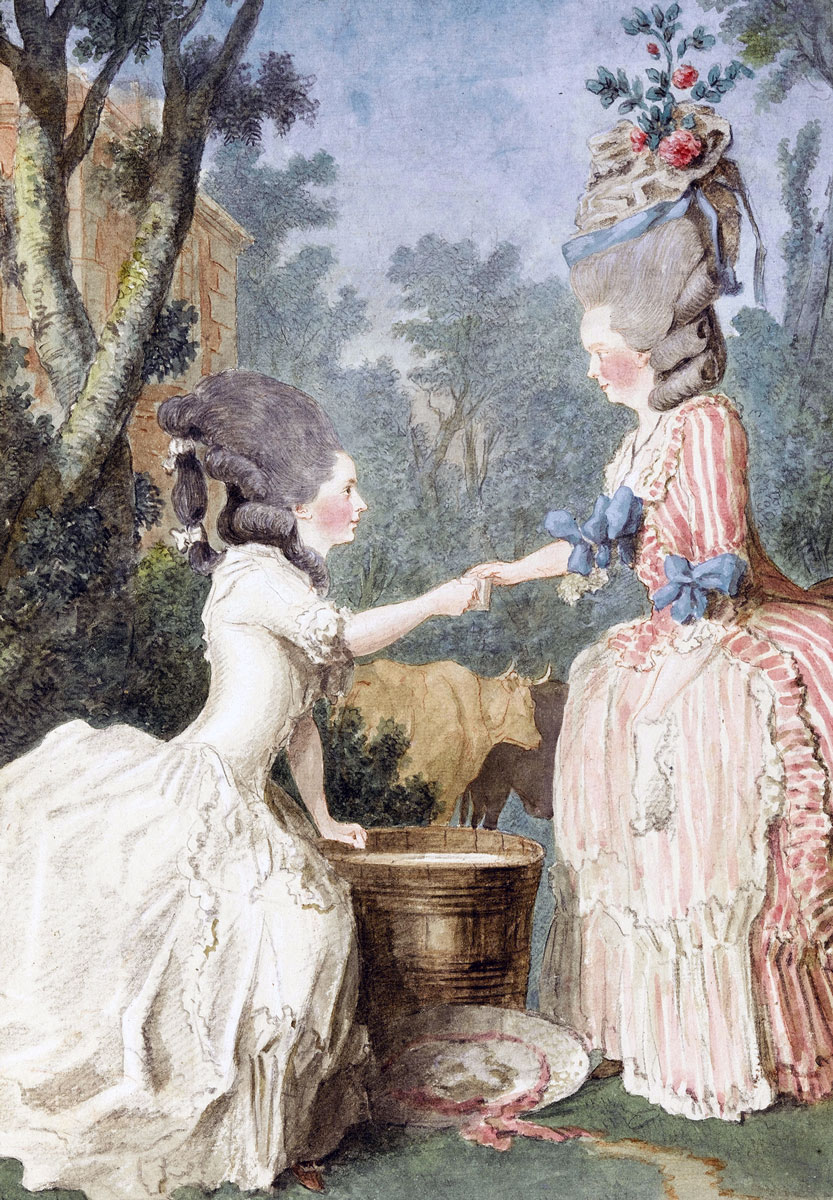
While the back-to-nature campaign contributed to a tragic demise for many aristocratic women, it had some undeniably comedic moments as well. Surely the most bizarre of the natural regimens invented in the eighteenth century to cure consumption, the vapors, and other urban illnesses was the “cow-house treatment.” This method was popularized by the English physician Thomas Beddoes, whose target audience was, as he described them, “the ghastly beauties of the court and city,” for whom “the ruddiness of the milk-maid has been a standing jest.’”[23] Beddoes recommended that such women take up residence in a cow stable for a goodly amount of time so that they could drink fresh milk, be surrounded by the comforting warmth of animals, and, above all, breathe in the curative fumes emitted by cow feces. Among those who attempted the regimen were the Princesse de Lamballe, a close friend of Marie-Antoinette, and Mrs. Sarah Finch, the daughter of the English scientist Joseph Priestley. Upon completing the treatment, the latter reported that though the stench made her “nauseous,” it also improved her condition and made her “more than ever a friend to the cows.”[24] Recognizing that not every patient was as game as Mrs. Finch, Beddoes came up with a less stringent version of the treatment that involved being confined to a heated apartment while vessels filled with cow shit were placed around the room. As far as I am aware, no eighteenth-century porcelain manufacturer designed a container for that.
- Rosalind Savill, The Wallace Collection Catalogue of Sèvres Porcelain, vol. 2 (London: Trustees of the Wallace Collection, 1988), p. 668.
- Robert Finlay, “The Pilgrim Art: The Culture of Porcelain in World History,” Journal of World History, vol. 9, no. 2 (Fall 1998), p. 175.
- I discuss the history of the milk cure in more detail in Dairy Queens: The Politics of Pastoral Architecture from Catherine de’ Medici to Marie-Antoinette (Cambridge, Mass: Harvard University Press, 2011). Unless otherwise indicated, the material contained in this article, especially that related to the physicians, architectural sites, and women patrons discussed below, derives from this book.
- William Coleman, “Health and Hygiene in the Encyclopédie: A Medical Doctrine for the Bourgeoisie,” Journal of the History of Medicine and Allied Sciences, vol. 29, no. 4 (October 1974), p. 406.
- Samuel Tissot, De la santé des gens de lettres [1768] (Geneva: Slatkine, 1981). See also Anne C. Vila, Enlightenment and Pathology: Sensibility in the Literature and Medicine of Eighteenth-Century France (Baltimore: Johns Hopkins University Press, 1998), pp. 187–196.
- Jean-Jacques Rousseau, Julie, ou La nouvelle Héloïse [1761], trans. Philip Stewart and Jean Vaché (Hanover: Dartmouth College, 1997), p. 372.
- Quoted from Venel’s entry “Lait” in Denis Diderot and Jean Le Rond d’Alembert, eds., Encyclopédie, ou Dictionnaire raisonné des sciences, des arts et des métiers (Paris: Briasson, 1751–1765).
- Jeremy D. Popkin, ed., Panorama of Paris: Selections from Le Tableau de Paris by Louis-Sébastien Mercier (University Park, Pa.: Pennsylvania State University Press, 1999), pp. 69, 141.
- “Franchipane” and other lab-engineered milk extracts are discussed in Barbara Orland, “Enlightened Milk: Reshaping a Bodily Substance into a Chemical Object,” in Ursula Klein and E. C. Spary, eds., Materials and Expertise in Early Modern Europe: Between Market and Laboratory (Chicago: University of Chicago Press, 2010), pp. 163–197.
- Rosalind Savill reports that the term trembleuse was used in Sèvres records from 1767, 1773, and 1774. She also notes that socketed saucers were invented in 1759 and were “probably intended for the sick.” See The Wallace Collection Catalogue, op. cit., pp. 674, 675.
- Samuel Richardson, Clarissa, or the History of a Young Lady [1747–1748] (London: Penguin Books, 1998), p. 1008; Pamela, or Virtue Rewarded [1740] (London: Penguin Classics, 1985), p. 373.
- Philippe Sylvestre Dufour, Traitez nouveaux et curieux du café, du thé et du chocolate (The Hague: Chez Adrian Moetjens, 1685). See also Christine Lahaussois, Porcelaines de Saint-Cloud (Paris: Réunion des musées nationaux, 1997).
- Amanda Lange, “Chocolate Preparation and Serving Vessels in Early North America,” in Louis E. Grivetti and Howard-Yana Shapiro, eds., Chocolate: History, Culture, and Heritage (Hoboken, NJ: John Wiley and Sons, Inc., 2009), p. 138.
- Numerous examples of Du Paquier trembleuses are described and illustrated in Johann Kräftner, ed., Baroque Luxury Porcelain: The Manufactories of Du Paquier in Vienna and of Carlo Ginori in Florence (Vienna: Prestel, 2005).
- Roy Porter, “Consumption: Disease of the Consumer Society?” in John Brewer and Roy Porter, eds., Consumption and the World of Goods (London: Routledge, 1993), p. 64. Porter uses the term “badge of gentility” to refer to a distinctively British form of nervous or consumptive illness that was dubbed “the English Malady.”
- See, for example, Pierre Hunauld, Dissertation sur les vapeurs et les pertes de sang (Paris: J.-N. Leloup, 1756), which claims that coffee and chocolate can exacerbate the symptoms of vaporous women. See p. 131.
- Quesnay is better known as the co-founder of Physiocracy, the eighteenth-century economic theory that extolled land as the true source of a nation’s vitality and health.
- Rosalind Savill, The Wallace Collection Catalogue, op. cit., p. 675.
- Louis de Carmontelle (Louis Carrogis), La Rosière, published in Proverbes et comedies posthumes de Carmontel, précédés d’une notice par Madame de Genlis, vol. 2 (Paris: Ladvocat, 1825).
- These pre-Revolutionary pamphlets (including one entitled Essai historique sur la vie de Marie-Antoinette d’Autriche) began to circulate widely in 1789, when royal censorship laws were lifted. See Simon Burrows, Blackmail, Scandal, and Revolution: London’s French Libellistes, 1758–92 (Manchester: Manchester University Press, 2006), chapter 6. Her trial transcripts are reprinted in Gérard Walter, ed., Procès de Marie-Antoinette (Brussels: Éditions Complexe, 1993).
- D. T. de Bienville, La Nymphomanie ou traité de la fureur utérine (Amsterdam: Marc-Michel Rey, 1771), pp. 99–124.
- See the pamphlet Les Fureurs utérines de Marie-Antoinette, femme de Louis XVI (Paris, 1791).
- Thomas Beddoes, Manual of Health; or, The Invalid Conducted Safely Through the Seasons (London: J. Johnson, 1806), p. 14, quoted in Roy Porter, “Reforming the Patient in the Age of Reform: Thomas Beddoes and Medical Practice,” in Roger French and Andrew Wear, eds., British Medicine in an Age of Reform (London: Routledge, 1991), p. 20.
- Quoted in Roy Porter, “Consumption: Disease of the Consumer Society?” op. cit., p. 70. See also Roy Porter, Doctor of Society: Thomas Beddoes and the Sick Trade in Late-Enlightenment England (London: Routledge, 1992).
Meredith Martin is an assistant professor of art history at Wellesley College. Her book, Dairy Queens: The Politics of Pastoral Architecture from Catherine de’ Medici to Marie-Antoinette, was just published by Harvard University Press (2011). Her new project concerns diplomatic relations between France and India in the eighteenth century.
Spotted an error? Email us at corrections at cabinetmagazine dot org.
If you’ve enjoyed the free articles that we offer on our site, please consider subscribing to our nonprofit magazine. You get twelve online issues and unlimited access to all our archives.